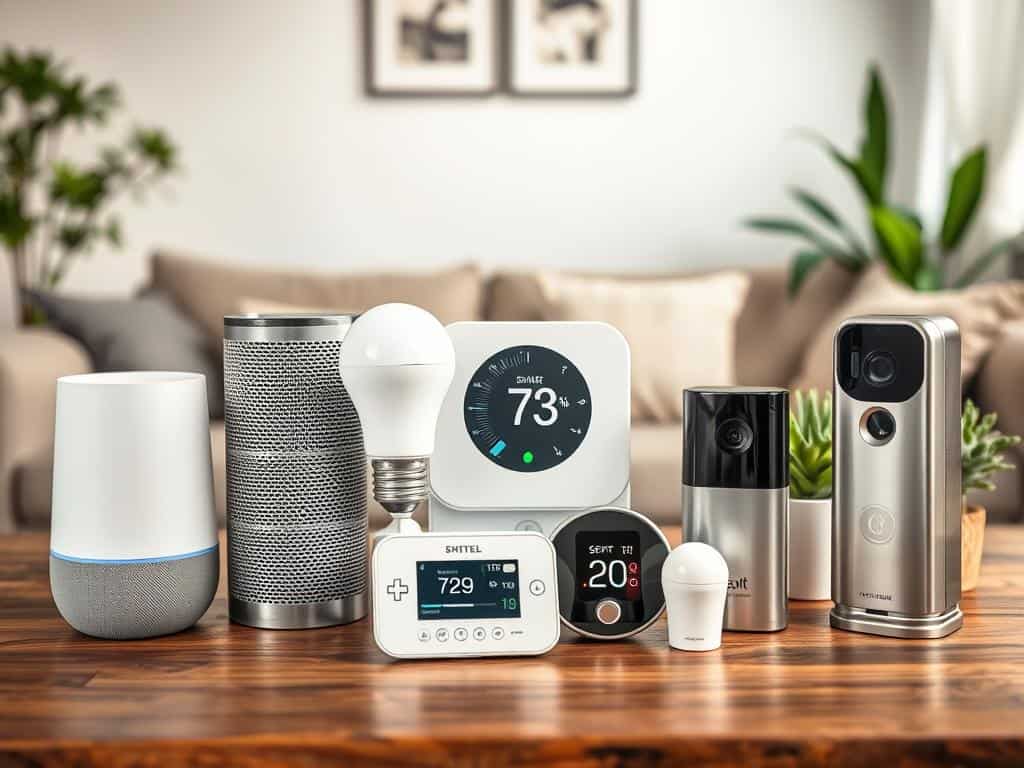Did you know over 70% of people want smart home tech but think it’s too expensive? The truth is, smart homes can be affordable and easy to set up. Thanks to new tech and cheaper smart devices, making your home connected is now possible without spending a lot.
I don’t have to spend thousands to start. I can begin with a few devices and add more later. Using energy-saving smart devices helps save money on bills. Brands like Eufy, Wyze, Meross, and Kasa Smart offer great options without needing to pay for subscriptions.
Starting my smart home journey, I first figure out what I need. Then, I plan which features to add first. With a smart plan and budget, I’m ready to dive into home automation.
Key Takeaways
- Assess your personal needs to create a tailored smart home plan.
- Focus on energy-efficient devices to reduce utility bills.
- Start with budget-friendly options from reputable brands.
- Monitor sales events for significant discounts on smart devices.
- Consider refurbished or second-hand options for cost savings.
- Utilize free automation apps to enhance your smart home experience.
- Regularly update firmware to optimize device performance and security.
Assess Your Needs for a Smart Home
Building a smart home needs careful planning and knowing what you need. First, figure out what’s most important to you. This might be better security with smart locks and cameras or making life easier with devices like Amazon Echo or Google Nest. Knowing what’s key helps you make smart choices.
Identifying Key Priorities
It’s important to know which features will add the most value. Over 55% of people worry about the security of smart home devices. Choosing secure devices can give you peace of mind. Also, think about how easy devices are to use, which is important for people with disabilities.
Setting a Realistic Budget
After deciding what’s most important, set a budget. This budget should cover both one-time and ongoing costs, like subscription fees. Staying within your budget means you can buy quality devices without overspending. Look into product details and warranties to make smart financial choices.
Starting Small and Expanding Gradually
Start with a few devices that will make a big difference right away. Growing your smart home slowly helps you save money and get used to new tech. Begin with a couple of reliable devices that have good reviews. This way, your smart home will be both useful and easy to handle.
Choosing Cost-Effective Smart Devices
Setting up a smart home on a budget means picking affordable smart devices. This way, I get efficient smart home automation without spending too much. There are many affordable options, like smart lighting and security devices, that fit well into my home.
Affordable Options for Home Automation
Smart speakers like the Amazon Echo Dot (5th gen) and Google Nest Mini are great for voice control. The Echo Dot costs under $50 and lets me access Alexa skills. The Nest Mini is known for its customizable colors and sound quality, making it a key hub for my home.
Smart Plugs and Lighting Solutions
The Wemo WiFi Smart Plug is a favorite of mine, priced at just $25. It’s small and works with Alexa, Google Home, and HomeKit. For smart lighting, the Wyze Bulb is a great choice at $8, with adjustable brightness and color.
The AiDot Linkind Wi-Fi Matter Smart Light Bulb supports 16 million colors and various white tones. This gives me control over my lighting setup.
Essential Security Devices for Connected Living
The Tapo C120 security camera is a great choice for under $40. It has color night vision and local storage, making it safe without subscription fees. Other good options include the Eufy S220 Indoor Cam and the Ultraloq U-Bolt Pro Wi-Fi Smart Lock, both designed for today’s connected lifestyles.
Integrating Devices Within Your Chosen Ecosystem
Choosing a compatible hub is key for ecosystem integration. Whether I choose Apple HomeKit, Amazon Alexa, or Google Home, a unified system is important. This ensures my smart devices work well together, making my smart home setup more functional and user-friendly.

Conclusion
Creating a smart home on a budget is both achievable and fulfilling. By knowing what I need and setting a budget, I can add devices that make my life easier and safer. There are many affordable choices that can make a big difference in my daily life.
Smart devices like energy-saving thermostats and smart lights let me control my home better. They also help me save energy and reduce my carbon footprint. Plus, smart cameras and sensors keep my home safe, giving me peace of mind.
As I move towards a smarter home, I keep an eye on new tech and trends. Being up-to-date helps me make the most of my smart home without breaking the bank. This way, I can enjoy more comfort and independence, even when facing new challenges.